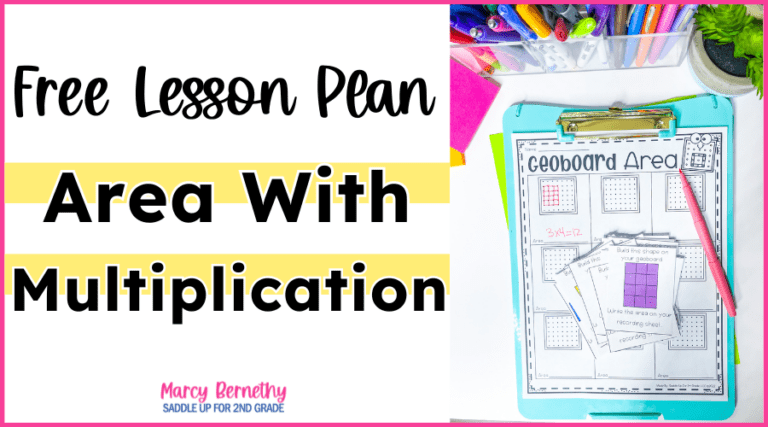

Join me for a FREE, Guided Math workshop to discover how to easily incorporate Guided Math into your current schedule!
Teaching rounding numbers in 3rd grade can be a really challenging concept for our students to grasp. This is especially true if they don’t have a strong foundation and understanding of place value. In 3rd grade, students are required to learn rounding to the nearest 10 and 100. Read on to learn 5 simple ways to introduce and reinforce the concept of rounding.

This post contains affiliate links. You can see my disclosure here.
Place value is essential when teaching rounding numbers in 3rd grade. It sets the foundation for so many mathematical skills, including rounding. Therefore, it’s really important to not rush through your place value lessons. If students don’t have place value down, they’ll only be more confused and frustrated if you try to move on to rounding too quickly.
For that reason, my 3rd grade rounding unit includes place value activities and lessons as well to help students review and work on that concept before introducing the concept of rounding.
See some of these activities in action over on my YouTube channel below.
Another important thing to keep in mind when teaching rounding numbers is that we need to focus on using precise language and mathematical vocabulary words with our students.
They need to know what place value they are rounding to. For example, instead of saying, “we’re going to round up or down,” ask them, “what place value are we rounding to?”
We want to ask our students guiding questions and encourage them to respond with phrases such as, “let’s round 37 to the nearest 10” instead of saying “let’s round 37 up.”
As you are asking questions and encouraging them to discuss and respond, be sure to also use those key vocabulary words to help support their thinking.
When teaching rounding numbers, it’s also important to provide students with various examples and strategies for rounding 2-digit and 3-digit numbers. No two students learn exactly the same, which is why it’s important to touch on a variety of ways to approach this concept. Visual models can be extremely helpful to move this process from concrete to abstract.
The best way to do this is to first introduce the rounding place. This is going to be different depending on if you are rounding to the nearest 10 or the nearest 100. When you round to the nearest 10, your rounding place is the number in the tens place.
For example, if you are rounding the number 37 to the nearest 10, the number 3 would be the number in the rounding place, because 3 is in the tens place.
If the number is 237 and you’re rounding to the nearest 10, 3 is still the rounding place because it is in the tens place. If you were rounding to the nearest 100, the rounding place would be 2 because the 2 is in the hundreds place.
In the examples and activities I’m going to show you today, we’re going to focus on rounding 2-digit numbers to the nearest 10.
When you first introduce the concept of rounding, I recommend using a modified 100s chart as a visual aid for your students.
As you can see in this picture, this chart is slightly different from a traditional 100s chart. This printable is included in my 3rd Grade Place Value and Rounding Unit.
The first thing you might notice is that there are 2 sets of numbers that are in the tens column, one on each side of the chart. In the middle of the chart, dividing the hundreds chart, there is a thicker black line, which will help students determine whether to round up or down. Across the top, I have added two arrows, one that says round down and one that says round up.
To see how this works, let’s say that students are to round the number 46 to the nearest 10. This modified 100s chart is a great visual aid for students with the dividing line, the numbers across the top, and the two sets of 10s numbers.
Students can see that 46 is on the right side of the line, which means they will round up to the nearest 10, which is 50. If the number were to fall on the left side of the line, they would round down to the nearest 10.
There are a lot of jingles that you can teach your students to help them determine if they should round up or down. The jingle I like to teach is: Five or more, add one more. Four or less, let it rest.
This means that students will look at the number in the ones place to determine how they should round. If the number is 56, then the number in the rounding place is the 5, because they’re rounding to the tens place. Then, they’ll look at the 6 and ask themselves, “is this 4 or less, let it rest or 5 or more, add one more?”
They can also look and see that 56 falls on the right side of the dividing line. Since 6 is greater than 5, they’ll round up to the nearest 10, which is 60.
The next activity I like to use for teaching rounding numbers is called Racing Into Rounding. This booklet walks students through the steps for introducing rounding.
First, they are going to identify what the rounding place of these numbers is. They could write the definition of the rounding place and then draw a box around each rounding place as an extra visual aid as they solve. In this example, they’ll draw a box around the number in the tens place, since they are rounding to the nearest 10.
Then, this booklet takes students through several different examples of rounding to the nearest 10. When it’s time to round, students will use the jingle to determine if the number in the rounding place is five or more or four or less. This will help them determine if they should let it rest and round down or add one more and round up.
If the number is 63, students would underline the 6 since it’s in the tens place. They would find the number on the 100s chart and circle it. This number would round down to 60 since 3 is less than 4. They can also visually see that 63 is to the left of the line on the 100s chart, which reinforces the need to round down to 60.
Another way that I like to practice rounding to the nearest 10 is by using an interactive work mat and a PowerPoint. In my 3rd grade place value and rounding unit, I have a PowerPoint that guides students through the thinking process when they are rounding numbers. It also prompts them with different questions as they think critically about the process.
This work mat goes along with the PowerPoint and is what students will practice rounding with as they go.
If students were to round the number 68 to the nearest 10, they would be guided by the PowerPoint to look at the tens that 68 is between, 60 and 70. They would find the number 68 on the work mat and either circle or color it.
Then, students would determine if it is closer to 60 or 70 by using the jingle from above and the number line. Since the 8 is greater than 5, 68 would round up to 70.
Another idea for rounding to the nearest 10 is to use a place value number line to practice rounding on a number line. A place value number line leaves the starting and ending tens place blank and then counts by ones in between. This allows students to easily change out the numbers when using this strategy.
When introducing rounding on a number line during my whole group lesson, I like to use beaded number lines.
In this picture example, you can see that the two ending tens are blank and then there is a beaded number line in the middle where it counts by ones. I laminate these so that students can change out the starting and ending tens with a dry erase marker to work with different numbers.
This is a really hands-on way to practice rounding various numbers to the nearest 10 during our whole group mini lesson. I also use this Round the Number activity alongside these number lines, which goes in our interactive notebooks.
For example, if students were rounding the number 46 to the nearest 10, they would write that 46 is in between 40 and 50 in their math journal. They can also write this on their beaded number line.
To represent 46, students would slide the bead on their beaded number line to the 6 to represent the number 46. Then, they would go through the prompt that 46 is between 40 and 50, but it is closer to 50. By having them use the beaded number line, they can use that bead on the 6 as another visual representation that 46 is closer to 50 rather than 40.
To practice rounding to the nearest 10 in a small group setting, I would use this Roll and Round activity along with various types of dice. I like using 6-sided dice and 10-sided dice to create larger numbers.
Students will roll the dice to create a 2-digit number, such as 34. On the place value line, they’d fill in the two tens that the number is between, 30 and 40. They would draw a dot on the number line or use a manipulative to mark the number 34 on the number line.
Students can then visually see that 34 is closer to 30 than 40, so when rounding to the nearest 10, it would round down to 30.
Students could also use a rounding 100s chart to help them solve, which is especially helpful for your lower learners who may struggle to understand which two tens a number is in between.
I hope these 5 simple ways for teaching rounding to the nearest 10 are helpful and provide your students with the tools and confidence they need to master this skill.
If you are teaching rounding in 3rd grade, check out my 3rd Grade Place Value and Rounding unit and resources in my website store below or in my TPT store.
This unit will help students develop a strong understanding of place value as well as rounding. It includes 20 days of done-for-you lesson plans to help you introduce and reinforce place value and rounding to the nearest 10 and 100.
Let me know which of these ideas you’d like to try first with your students by leaving me a comment below!

Math should be fun, not stressful. Ditch the timed math fact tests and replace them with math games that will help your students learn and retain information more effectively.
© Saddle Up for 2nd Grade • Website by KristenDoyle.co


